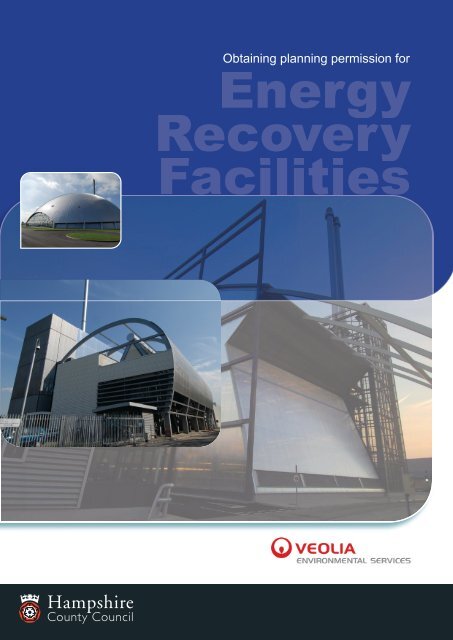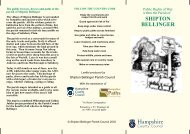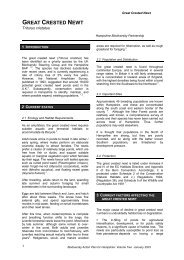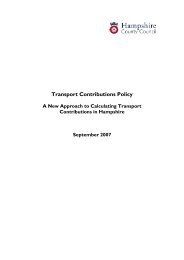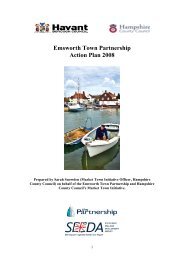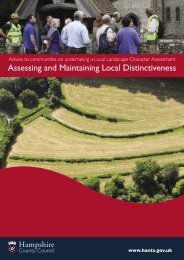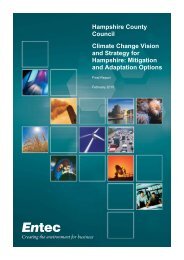erf planning.indd - Hampshire County Council
erf planning.indd - Hampshire County Council
erf planning.indd - Hampshire County Council
- No tags were found...
You also want an ePaper? Increase the reach of your titles
YUMPU automatically turns print PDFs into web optimized ePapers that Google loves.
IntroductionOver the past ten years <strong>Hampshire</strong> <strong>County</strong> <strong>Council</strong> and the two unitary authorities ofPortsmouth City <strong>Council</strong> and Southampton City <strong>Council</strong> have maintained a positionamong the best p<strong>erf</strong>orming authorities in the country in terms of both recycling andlandfi ll avoidance. In fact, for the year 2006-2007, the combined recycling rate forthese authorities was 36%, with landfi ll diversion at 85% – the highest in the country.<strong>Hampshire</strong>’s achievements can be largely attributed to an integrated waste managementstrategy known as Project Integra: a partnership between the 13 district and unitarycouncils as waste collection authorities, <strong>Hampshire</strong> <strong>County</strong> <strong>Council</strong> and the unitaries aswaste disposal authorities and the private waste contractor Veolia Environmental Services.The integrated waste contract required a whole new infrastructure to be built, and so<strong>planning</strong> permission had to be gained for a range of facilities – including in particularthree energy recovery facilities (ERFs). Today, all facilities are operational, and the ERFsare making a major contribution to the waste management of the local authoritiesconcerned, enabling them to exceed their LATS requirements.Yet Project Integra was able to achieve all of this when most authorities were moving awayfrom incineration altogether. How was this achieved and what can be learned from thissuccessful experience? With incineration and energy from waste becoming increasinglypolitically sensitive, this paper is an insight into gaining the <strong>planning</strong> permission for thoseenergy recovery facilities and refl ects on the lessons there are to be learned.Obtaining <strong>planning</strong> permission for energy recovery facilities
The achievement<strong>Hampshire</strong> and the unitary authorities of Portsmouth and Southampton benefi t from asuite of modern municipal waste facilities which are an essential part of an integratedwaste management programme, achieving a recycling rate of 36%, and providing thefoundation for a reduction in landfi ll to 15% of the 850,000 tonnes per annum (tpa) thatis generated in the county and the two cities. The network of facilities includes:• 26 (one fi fth of which are new) household waste recycling centres (HWRCs)• 10 waste transfer stations• two Material Recovery Facilities (MRFs) – 157,000 tpa• three centralised green waste composting facilities – 100,000 tpa• three municipal waste Energy Recovery Facilities (ERFs) – 420,000+ tpa.The three ERFs generate close to 40 megawatts of electricity each year – enough tosupply up to 50,000 homes. Within the next two years, 100,000 tpa of bottom ash thatis produced by the plants will be reprocessed into a secondary aggregate to be usedin sustainable construction projects. There are also plans to further improve the HWRCnetwork and to build two additional waste transfer stations.Due to the signifi cantinvestment in wasteinfrastructure and recyclingp<strong>erf</strong>ormance, <strong>Hampshire</strong> andthe city councils are diverting85% of waste from landfi ll.Consequently, landfi ll directiveobligations for 2010 and 2013will be met.
HistoryThe “Portsmouth Burner”Historically, <strong>Hampshire</strong> has not had large voids available for landfi ll, and during the1960s and 1970s built a number of small municipal incinerators. In the late 1980s it wasfound that landfi ll capacity was rapidly declining and there was a need to replace theincinerators which were becoming obsolete. In response to this situation the <strong>County</strong><strong>Council</strong> adopted a waste management strategy which promoted additional recycling– then running at about 8% – but also placed emphasis on replacing the incineratorswith state of the art energy recovery facilities.Investigations at the time demonstrated the case for economies of scale and a proposalwas developed for one 350,000 tpa facility to serve the whole of South <strong>Hampshire</strong>. It isimportant to note that, at this time, waste management was not a high profi le activity andthe political priority was to deliver a replacement system at a minimum additional cost. Inthe absence of a Waste Local Plan for identifying appropriate development sites for sucha plant, the <strong>County</strong> <strong>Council</strong> asked for tenders from three companies to redevelop a massburn energy recovery incinerator on the site of the then recently closed small incinerator inPortsmouth. Tenders were to be on a design, fi nance, build and operate basis.The company which won the tender (not Veolia) submitted a <strong>planning</strong> application fora 350,000 tpa plant at the end of 1991. However, the press, public and local politicsreacted negatively and a campaign to oppose the development was formed. The mainarguments behind the opposition were that:• the plant would be too big and the choice was more to do with fi nancial issues thanenvironmental ones• it would make Portsmouth the rubbish dump for <strong>Hampshire</strong>• other sites had not been fully considered• it was not needed – the waste should be recycled and the incinerator would prejudicefuture recycling (there were no solid plans for increasing recycling at the time)• there were overwhelming traffi c issues• the plant had no particular architectural merit• there was concern about pollution and health• there were better ways of managing waste.Obtaining <strong>planning</strong> permission for energy recovery facilities
Although some public engagement processes were undertaken, these were almostentirely counter-productive and the local newspaper ran a very effective “Ban theBurner” campaign based on the above points. The situation was not helped by thecontractor’s apparent lack of understanding of the community concerns and inability torespond in an appropriate way – for example an artist’s impression of the height of thenew plant was found to be misleading.The pressure on the <strong>County</strong> <strong>Council</strong> was so intense that following submission of the<strong>planning</strong> application for the plant, and despite the applicant being the <strong>Council</strong>’s owncontractor, it was obliged to refuse the application and recommend that a strategy bedeveloped based on increased recycling and smaller, well designed energy recoveryfacilities. Although in hindsight this has worked to <strong>Hampshire</strong>’s advantage, at the timeit left the <strong>County</strong> <strong>Council</strong>’s entire waste strategy in collapse. Landfi ll was running outand the four ageing incinerators were facing the upcoming (1996) change in emissionsregulations which were inevitably going to close them down.Community engagementFollowing the failure of the “Portsmouth Burner”, a survey of key opinion formers andobjectors was carried out. The fact that the <strong>County</strong> <strong>Council</strong> had decided to undertakepublic consultation after a fi rm proposal had been adopted was found to have beena major source of frustration. The survey also found there was much communitywillingness to help fi nd a solution – provided that <strong>Hampshire</strong> <strong>County</strong> <strong>Council</strong> did notenter into consultations having already made a decision.The <strong>County</strong> <strong>Council</strong> recognised that if it was going to address the looming waste disposalcrisis it had to rethink its whole approach to the subject, and moreover, it had to have somepublic acceptance and political endorsement of this approach in both strategic and landuse <strong>planning</strong> terms.The approach was reformed accordingly, based on three parallel but related processes.• Engage the public in a “bottom-up” process about the issues it faced and thealternative approaches to solving them.• Develop an integrated approach whereby waste treatment was founded on the wastemanagement hierarchy, i.e. recycling and composting fi rst and foremost, leaving theresidual waste stream to be treated in a manner yet to be decided. It became clearthat if this was to work, the <strong>County</strong> <strong>Council</strong> would have to work in partnership with thedistrict councils as waste collection authorities.
• Ensure the <strong>Hampshire</strong>, Portsmouth and Southampton Minerals and Waste LocalPlan being prepared at the time addressed the physical and land use issues andinvestigated site options.In addition to the above, a concerted effort was made to build a cross-party politicalconsensus within the <strong>County</strong> <strong>Council</strong> and with the districts. This approach was successfuland the agreement largely held throughout the whole process. It was perhaps one of thekey factors in <strong>Hampshire</strong>’s subsequent success. Community engagement developedinto a continuous thread that has run through the whole process of developing andimplementing what became known as the Project Integra strategy.The initial phase took place over 18 months using three independently facilitated forumscomprising community representatives and other interest leaders for each of threegeographic areas of <strong>Hampshire</strong> based on groupings of the local authorities. Politicians andthe waste industry were permitted to be observers at the meetings, but not allowed to takepart in the discussions other than to give expert advice when requested. The forums, whichwere independently chairedand facilitated, investigatedwaste management options,looked at different technologiesand enquired into variousenvironmental and healthissues. The forums attendedvisits both within the UKand overseas and receivedpresentations from independentexperts. The deliberations of theforums were communicated to2000 key opinion formers andother interested communityrepresentatives via regularnewsletters. The issues werealso communicated via the localmedia.Obtaining <strong>planning</strong> permission for energy recovery facilities
At the end of this process the forums recommended a broad strategy based on anintegrated approach to household waste that would:• minimise the production of waste• develop recycling and composting• address the residual wastes.They also made recommendations as to the key issues that needed to be addressed inorder to reduce concerns over incineration, and asked that a non-incineration option besought in a future contracting process. All three forums came to broadly similar conclusions.In response to this, the <strong>County</strong> <strong>Council</strong> decided that the best way to address thecommunity aspirations was to set up three waste disposal contracts – one for eachof the geographic divisions of <strong>Hampshire</strong>. What was signifi cantly different with theproposed contracts from those that preceded them was that they were based on theprovision of a service with p<strong>erf</strong>ormance targets, rather than just requiring the provisionand operation of infrastructure. It was perhaps one of the fi rst output contracts in publicsector waste management.As a result of the tendering process, <strong>Hampshire</strong> Waste Services (HWS) – a wholly ownedsubsidiary of the Onyx Environmental Group (now Veolia Environmental Services) – wasselected as the contractor for the services in all three areas. <strong>Hampshire</strong> Waste Servicesoffered a menu of infrastructure options to meet the service objectives, including three ERFplants, four Material Recovery Facilities (MRFs), three composting sites and a network oftransfer facilities to enable the materials and waste streams to be transported in a moreeffi cient manner. As with other tenderers, HWS offered landfi ll as their non-incineration option.The new contract started on 1 January 1996, following which the <strong>County</strong> <strong>Council</strong>undertook a further round of public consultation on the infrastructure options and over70% of respondents supported the incineration proposals. This consultation usedmarket research and focus groups to seek views from the normally “silent majority”.These fi ndings allowed the strategy to be fi rmed up as follows:• keep waste arisings at 1995 levels• 25% recycling rate by 2000, with a target of 40% in the longer term• three small scale incinerators dealing with 75% of residual waste• landfi ll for the waste left over, including process residues.As part of the contract, a partnership approach was initiated that brought in thewaste collection authorities so that all public and private players were engaged in anintegrated approach to waste management. Project Integra was born.
<strong>Hampshire</strong>, Portsmouth and Southampton Minerals and Waste Local PlanWhilst the community engagement processes and resulting contractual arrangementswere established, the <strong>Hampshire</strong>, Portsmouth and Southampton Minerals and WasteLocal Plan was undergoing a lengthy statutory process. The draft Plan set out criteriafor locating major waste facilities and identifi ed eight sites suitable in land use terms forintegrated processing plants.The Plan was the subject of a lengthy year-long public enquiry, where strategic aswell as land use and site specifi c issues were examined. Special scrutiny was givento the proposed site options and site selection process. In his report, the Inspectorrecommended that four of the eight sites be deleted for traffi c, land use andenvironmental reasons. The four remaining sites were:• Chineham near Basingstoke – site of a former incinerator plus additional land• Portsmouth – site of the ill fated “Burner” proposal• Marchwood near Southampton – site within a large industrial estate which had oncebeen a power station• Fawley – site adjacent to a hazardous waste incinerator and petrochemical complex.The <strong>Council</strong> adopted these recommendations.The branding of Project IntegraThe title ‘Project Integra’ came initially from the name the contractor, <strong>Hampshire</strong> WasteServices, gave to their proposed integrated waste management service. The namingof the tender was effectively a branding decision and along with the name came a logoand indeed, a complete identity. Even the logo was symbolic of <strong>Hampshire</strong> and thethree geographic regions.This branding proved to be very effective and within a short period of time the entirewaste management programme became known as Project Integra. The logo appearedon local authority collection vehicles as well as being adopted by the contractor.Project Integra acted as a common platform for the district, city and county councilsto promote and explain the strategy. Being non-political and representing sharedvalues and goals, it also acted as a binding force between the previously disparatelocal authorities. Project Integra went on to symbolise the partnership that developedbetween the county, the cities and the eleven district councils, enabling the strategy tobe implemented throughout the geographical county region.Obtaining <strong>planning</strong> permission for energy recovery facilities
Planning applicationsUnder the terms of the contracts, HWS had responsibility for not only building andoperating services and plants, but also for obtaining the relevant consents, including<strong>planning</strong> permission. In the event, an important aspect of the adopted approach wasthat they worked in partnership with the <strong>Council</strong> as client, and that joint decisions weremade as to the application strategy including timings, etc, even where these implicationsimpacted development of the daily service. After gaining permissions for some lesscontroversial but nonetheless important facilities – a network of waste transfer stationsand a state of the art Materials Recovery Facility in Portsmouth – the issue of energy fromwaste facilities was addressed. The following approach was adopted:• three of the sites identifi ed in the Local Plan were chosen• contact groups comprised of local people were formed before applications wereprepared to look at issues arising from the proposals• environmental studies were undertaken well in advance of submission of theapplications• close attention was given to the visual appearance of the plants, deploying a highstandard of architecture.A series of <strong>planning</strong>applications were thensubmitted. It was decidedhowever, that the relevantenvironmental permits from theEnvironment Agency should beapplied for simultaneously sothat the non-<strong>planning</strong> aspectsof pollution control could beaddressed and enable theAgency to respond fully toconsultations on the <strong>planning</strong>applications.
Chineham ERFThe fi rst <strong>planning</strong> application was submitted in 1998 fora 90,000 tpa facility at the site of the former municipalincinerator in Chineham, near Basingstoke. Therewas a degree of community resistance, largely overhealth concerns, and several hundred objections werereceived. In light of this, the <strong>Council</strong> did not proceedwith determining the application until the EnvironmentAgency had approved their environment permit in principle. Once the Agency wasable to provide advice to the <strong>Council</strong> the application was reported to a special meetingof its <strong>planning</strong> committee at which a large number of deputations were made by thepublic. The Committee was satisfi ed that the application had addressed all the issuesadequately and granted permission, subject to improvements to the main access,environmental monitoring and the setting up of a liaison panel.Construction of the Chineham ERF commenced in 2000 and fi nished commissioning inFebruary 2003. Since then it has processed waste at its design capacity and produces7 MW of electricity.From the time of construction a liaison panel comprising local interests has met.Principal issues have been emissions – all of which have been well within standards,night time illumination within the plant – now managed to minimise impact, andmiscellaneous complaintsabout black smoke andodour – none of which havebeen founded. Recentenvironmental studies onground contaminationcompared to baselineinvestigations beforepermission was grantedhave demonstrated nothingunusual.Obtaining <strong>planning</strong> permission for energy recovery facilities
Portsmouth ERFThe second application was submitted to PortsmouthCity <strong>Council</strong> in 1998 for a 165,000 tpa plant on the oldincinerator site. Similar issues arose as in the Chinehamcase, but there was more local opposition and despitea recommendation to the contrary by the offi cers,permission was refused.HWS appealed against the decision and a Local Public Inquiry was held. The PlanningInspector’s report dealt exhaustively with the issues of traffi c, health, technology andalternative waste strategies and human rights, and recommended the appeal beupheld. The Secretary of State concurred and the Portsmouth ERF went into service inFebruary 2005.
Marchwood ERFThe Marchwood application was submitted in 1999 for afacility of similar capacity to that at Portsmouth. A featureof this proposal was the dome design on a wat<strong>erf</strong>rontlocation which resonated with another structure beingbuilt in London. Unlike the other ERF applications therewas very little community opposition – objection letterstotalled 50 – the main concern being traffi c issues andinvestment to resolve them. Despite this, the environmental interest group CommunitiesAgainst Toxics (CATs) challenged the permission granted by the <strong>County</strong> <strong>Council</strong> onthe basis of int<strong>erf</strong>erence with human rights through potential impacts on health. Theapplication for leave was granted by the High Court in 2001 but the challenge wasimmediately and comprehensively dismissed.The Marchwood ERF was commissioned in October 2004 – although the fi nal claddingtook some further time to complete. Extensive road improvements have taken place toaddress local community concerns but few issues now concern the liaison panel – themain remaining one being the redevelopment of the former municipal incinerator site onthe edge of the village. Today, there is evidence of pride in the design of the ERF as alocal feature.Obtaining <strong>planning</strong> permission for energy recovery facilities
Opposition groupsOpposition to the strategy was present throughout the two phases of generalconsultation and the site specifi c consultations leading up to determination of the<strong>planning</strong> applications. As described previously, the nature of this opposition varied intime and with location.Despite their successful 1991 campaign, Portsmouth’s “Ban the Burner” group hadvirtually disbanded by the time of the new <strong>planning</strong> applications in 1998-99. Duringthe subsequent consultations and run up to the Portsmouth City <strong>Council</strong> PlanningCommittee meeting to determine the application, the group never again establisheditself to the same extent. Nevertheless, an opposition group did form in Portsmouthsupported by Friends of the Earth that campaigned more against an incinerator inPortsmouth than against incineration being included within the strategy. However, thegroup failed to engage the local newspapers in a campaign and media comment inPortsmouth was generally well-balanced.The most persistent and sometimes vociferous campaign group emerged during thefi rst phase of consultation. Based in Southampton, Communities against Toxics (CATs)began its campaign in 1994, leading to demonstrations at the then existing incineratorsthe following year. The group also made demonstrations at meetings of the <strong>County</strong><strong>Council</strong>’s Public Protection Committee and achieved a continuous presence in theSouthampton local newspapers for several years. CATs focused almost exclusivelyon the Marchwood application and other than one foray into Portsmouth where theyparticipated in a private debate with HWS chaired by the City <strong>Council</strong>, CATs had virtuallyno presence away from the debate on the Waste Local Plan and the Marchwood ERFPlanning Application, and little community support. Although it was a member of CATswho challenged the granting of the Marchwood Planning Application, the campaigngroup’s presence gradually diminished after failing in the judicial review.In Basingstoke the opposition was of a different nature. The local MP adopted resistanceto the <strong>planning</strong> application at Chineham as a local party political issue and attempted tohave the <strong>planning</strong> permission overturned. Although there was local resistance from theoutset, the campaign against the ERF in the Basingstoke area was focused on the sitespecifi c consultations carried out by HWS. In consequence, public meetings becamevociferous and managed to make banner headlines in the local media. Although the localnewspaper identifi ed with the opposition group and announced a supporting campaign, itwas never suffi cient to infl uence the Planning Committee and permission to construct waspassed unanimously with just a single abstention.
The way forwardThe commissioning of the three ERFs is only the end of the fi rst chapter of the wastemanagement agenda in <strong>Hampshire</strong>. Thoughts and energies are now increasinglydirected to moving from a waste focused framework to that of resource management andhow the future development of <strong>Hampshire</strong> can address the challenge of climate change.A good start has been made through a comprehensive review with the public andstakeholders of how all discards – and the overlapping issue of minerals – shouldbe regarded as material resources and managed accordingly. The <strong>County</strong> <strong>Council</strong>published a document entitled More from Less in 2005, setting out the communityaspirations for material resources. This in turn has set the agenda, informing a newspatial <strong>planning</strong> strategy - the <strong>Hampshire</strong> Minerals and Waste Core Strategy - adoptedin July 2007 by the <strong>County</strong> and city councils and recently created New Forest NationalPark Authority. Arising from this will be a need for more, different infrastructure of whichEnergy from Waste (EfW) will be a key element. What technology will be deployedremains to be seen, but whatever it is, the lessons learnt in <strong>Hampshire</strong> in the last 15years will need to be applied.For a sustainable future, we need to promote energy recovery as a renewable energyoption which benefi ts the community rather than a waste treatment solution seenas a “bad neighbour”. To be credible in achieving this, we need to maximise energyeffi ciency through schemes such as district heating so that energy from waste standsup as a renewable energy option in its own right. This does open up issues on heatingdistribution infrastructures, but brings the debate on the future of the sustainable urbanenvironment into the heart of the community.The debate is now underway in <strong>Hampshire</strong> and it is likely that before long districtheating using waste as a heat source will be a reality. In future, rather than consideringERFs as stand alone facilities, we need to integrate it within new developments of majorenergy users. This means a different approach to spatial <strong>planning</strong> with much closerworking with local stakeholders.Obtaining <strong>planning</strong> permission for energy recovery facilities
Framework for obtaining <strong>planning</strong> permissionfor ERFsLessons learnedThere are no authoritative rules for successfully gaining <strong>planning</strong> permission for energyrecovery facilities. Each success story is different; each failure is the same!There are, however, lessons to be learnt, although they have to be interpretedaccording to the situation that applies. These lessons are detailed below, and althoughother models may be adopted for obtaining <strong>planning</strong> permission for contentiousdevelopments such as ERFs, the authors maintain that without these features beingpresent, failures are being courted.BalanceOne feature common to failed ERF projects is their perception – rightly or wrongly– as incineration solutions to the waste management problems of an area. This wasvery much the perception of the “Portsmouth Burner” and very much instrumental inits downfall. It is important that the ERF element of a waste management strategy ispromoted as one aspect of a solution that is much greater in scope, and is essentiallythe fi nal step in the resource recovery process. The role of the ERF is to recover theenergy from the residual waste stream and reduction of the volume of material to bedisposed in landfi ll. With an ERF in the system, there is potential for landfi ll diversion ofover 90%.It was for this reason in <strong>Hampshire</strong>that before the applications forERFs were submitted, otherwaste infrastructure proposalswere progressed. These includedapplications for composting,materials recovery and othersupporting facilities. Therefore,when the applications for ERFswere submitted there was clearevidence that they were part ofa total approach to the wasteproblem.
PartnershipAnother important feature of the <strong>Hampshire</strong> approach was that it was based on apartnership between all the involved local authorities and then included the contractor.This had several elements, as detailed below.Firstly, the <strong>County</strong> <strong>Council</strong> as waste disposal authority worked closely with the otherWDAs (Portsmouth and Southampton) and with the district councils as waste collectionauthorities to arrive at a common purpose. This was a clear demonstration to thecommunity that the various pieces of the waste management jigsaw were being fi ttedtogether. The impression is that this approach has not been implemented elsewhere,however the Government’s more recent requirement for Joint Municipal WasteManagement Strategies clearly seeks to address this lack of collaborative approach.A second element has been the engagement of the chosen waste managementcontractor into this partnership to form Project Integra. This helped overcome theproblems of the traditional client-contractor relationship. The development of ProjectIntegra as a non-political vehicle with a set of objectives with which all local authoritiescould identify played a major role in enabling the partnership to grow and fl ourish.Finally, the Waste Planning Authority was engaged in the issues of waste managementat an early stage. Despite the responsibilities of the Waste Planning Authority asregulator with all the quasi-judicial responsibilities this involves, it was decided that<strong>planning</strong> offi cers should be informed of the issues throughout and be available to giveappropriate advice as projects evolved. It is evident elsewhere that this communicationhas not been developed, with negative results.LeadershipUntil recently theGovernment has beensomewhat ambivalentabout ERFs and thishas had a detrimentaleffect on the progressof such projects. Inorder to compensatefor this, effort wasmade to ensurethat members of allObtaining <strong>planning</strong> permission for energy recovery facilities
<strong>Hampshire</strong> councils – including the two unitary authorities – were aware of the issues andthe options for waste management. Significant investment was made by both officersand the contractor to make information available, including showing Members referenceplants, explaining how other countries had addressed the problem and briefings byindependent experts. This helped facilitate the building of an agreement across theauthorities that withstood political change.Spatial <strong>planning</strong>A key element in <strong>Hampshire</strong>’s success story has been the establishment of a landuseframework that identifies sites for major waste developments. Despite the timeand resources involved in completing the <strong>Hampshire</strong>, Portsmouth and SouthamptonMinerals and Waste Local Plan this undoubtedly resolved the issues where wastemanagement investment should be located. Without this framework addressing theissue of potential sites at an early stage, it would have been difficult to withstand thechallenges to the <strong>planning</strong> applications that did occur.Under the new <strong>planning</strong> system, national, regional and local strategic policy for theprovision of infrastructure and developments is more integrated. It also explicitlyincorporates processes for identifying spatial options for waste managementdevelopment in relation to environmental and other sustainable development objectives.This should facilitate the resolution of <strong>planning</strong> issues and provide a more coherentframework for identifying sites for waste management.DesignA significant concern of the <strong>County</strong> <strong>Council</strong> when dealing with the “Portsmouth Burner”application related to design issues. It was felt that more care should be given to theappearance of infrastructure that p<strong>erf</strong>orms such an important service. Accordingly,both the waste contracts and Local Plan required all waste sites, but particularly theproposed ERF to be designed to a high standard particularly as such buildings areinevitably prominent features. All three ERFs have been designed by an internationallyknown French architect who specialises in waste infrastructure, and two of the plantshave already gained engineering design awards in recognition. This has set a standardfor all the infrastructure in <strong>Hampshire</strong> and has undoubtedly helped it gain acceptability.This approach has now been recognised in Government guidance as an importantconsideration in the delivery of waste facilities.
DetailIn preparing the <strong>planning</strong> applications, considerable effort was made in addressingall the concerns arising from extensive consultations with the communities involved.As well as the attention given to the design of the plantsin recognition of their signifi cant visual impact, thisincluded commissioning of baseline studies on traffi c,air quality, ground contamination, health and otherissues, and assessments of how the plants would affectthese issues. As a result, the <strong>planning</strong> applications werecomprehensively detailed and models for this type ofdevelopment were produced. This helped the <strong>planning</strong>authorities process the applications effi ciently, and haveconfi dence that the recommendations had adequateevidential support.ConsultationA major feature of the story was the degree of consultation involved. The strategy wasborne out of extensive engagement of community interests. The preparation of the<strong>planning</strong> framework invited public participation and was subject to the scrutiny of apublic enquiry. The preparation of the <strong>planning</strong> applications involved local intereststhrough contact groups. Finally, the <strong>planning</strong> authorities arranged meetings and allowedpeople to speak at the meetings where the <strong>planning</strong> decision was made. Overall, thewhole process was very transparent and particular effort was made by all concerned toensure that there were no gaps in procedure that would expose the decision-makingprocess to successful legal challenge.CommunicationsA proactive, rather than reactive, approach to media communications was undertaken.Key opinion formers and media editors were thoroughly briefed and positive storieswere released. The effectiveness of this approach became evident when the newspaperthat led the campaign against the original “Portsmouth Burner” became supportive ofthe strategy and the proposed ERF for Portsmouth.By the same token the development of local liaison groups also helped facilitate theapproval process. The fact that proposals were subject to discussion and there wassome element of community involvement made an important contribution to makingthem more acceptable (or less unacceptable) to local people.Obtaining <strong>planning</strong> permission for energy recovery facilities
ConclusionThe model followed in <strong>Hampshire</strong> to gain the <strong>planning</strong>permission required for ERFs is not the only one available,but there are a number of lessons to be learned fromthe experience. As a result of the detailed waste strategyadopted and subsequent exhaustive <strong>planning</strong>, <strong>Hampshire</strong>stands as possibly the most successful example of anintegrated household waste strategy in the country, and is amongst the very best inEurope.
EnergyRecoveryFacilitiesPrinted on 100% Recycled Paper


